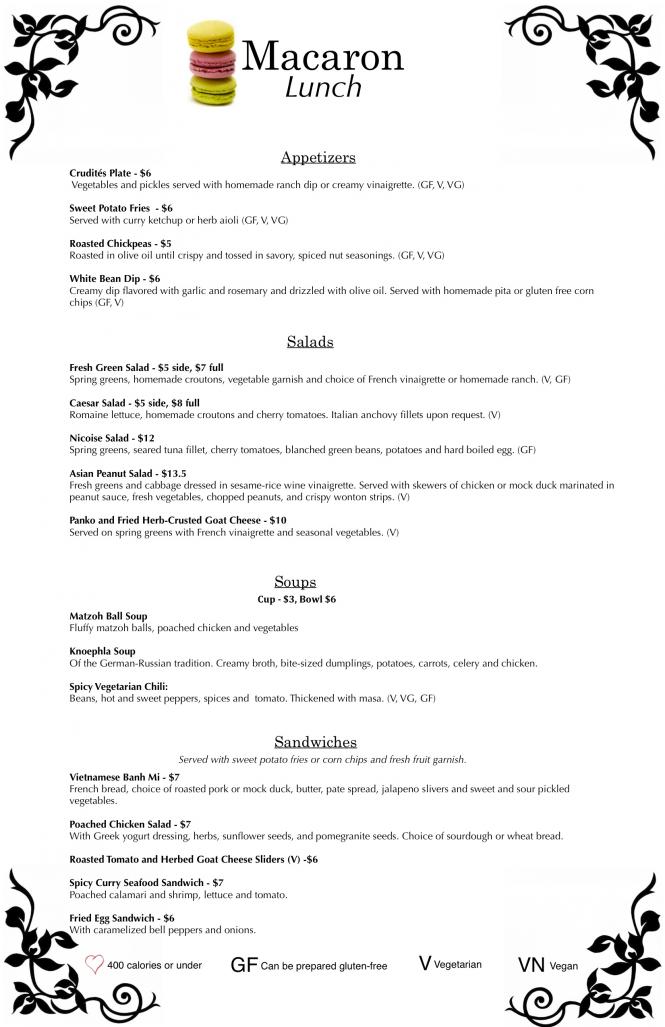This is the fifth post in a series about attending culinary school. Also check out earlier posts on wine tasting class, poultry class, cooking in quantity, and the introduction to the series.
My culinary school’s menu planning class brings to mind the struggling restaurants featured on Kitchen Nightmares and Restaurant Impossible. Their menus are often too long. They include an overabundance of entrees that confuse the kitchen staff and cause them to take shortcuts in order to avoid wasting the excess food. They don’t adhere to a cohesive theme or they stubbornly hold on to an ill-fitting one. Some of these restaurants serve menus that don’t fit the needs and wants of their communities, though they may have decades ago, or charge prices the community is not willing to pay.
Moorhead Community and Technical College’s culinary program is doing their darndest to prepare us not to be kitchen nightmares. First year students are enrolled in Kitchen Math and Menu Planning courses while second year students build upon this curriculum by studying Purchasing and Pricing. The first-year Menu Planning course – in which we develop our own fake restaurant – allows us to practice creating menus in an alternative reality where copyright laws don’t exist and anyone can be our business partner. Next year will take us closer to reality as we plan the actual menus for the school’s breakfast, lunch, and themed buffets that fit the program’s budget and kitchen equipment.
Location & Demographics
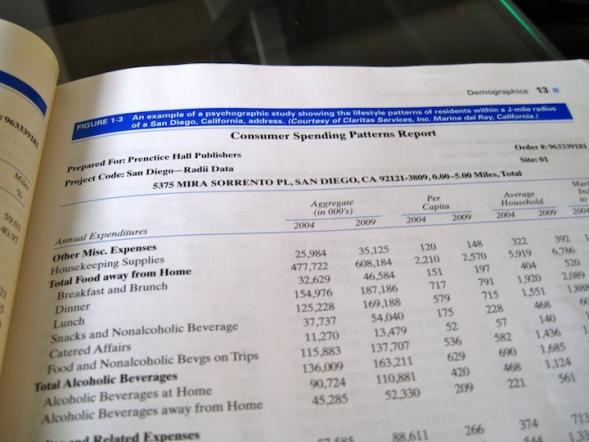 An example of a consumer spending reportBefore we began planning our
restaurant’s name or theme, we were encouraged to imagine where we wanted to
open our restaurant and talked about how we could research whether our concept
fit within the community. Those who open restaurants should extensively
research their prospective community by examining the most recent census
information, conducting feasibility studies, and examining consumer-spending
reports for trends regarding age, household information, and income within the
community. Potential restaurateurs would probably want to search for clues such
as whether or not a community might contain a large segment of households with
more or less disposable income. Besides demographic information about a
community’s households, it’s also important to research one’s competition
within the community. Is the market oversaturated with restaurants or lacking
in a certain genre?
An example of a consumer spending reportBefore we began planning our
restaurant’s name or theme, we were encouraged to imagine where we wanted to
open our restaurant and talked about how we could research whether our concept
fit within the community. Those who open restaurants should extensively
research their prospective community by examining the most recent census
information, conducting feasibility studies, and examining consumer-spending
reports for trends regarding age, household information, and income within the
community. Potential restaurateurs would probably want to search for clues such
as whether or not a community might contain a large segment of households with
more or less disposable income. Besides demographic information about a
community’s households, it’s also important to research one’s competition
within the community. Is the market oversaturated with restaurants or lacking
in a certain genre?
Opening a restaurant in Fargo might differ from opening a restaurant in the Twin Cities. Just from personal observations, I have noticed that Fargo’s food culture is gaining momentum as more and more people write and discuss food in social media, host food events, and spotlight locally-made products. Still, there are many chain restaurants and few places that offer fine dining. In the Twin Cities, it seems there are food trucks on every corner, as opposed to Fargo, where I can count all of the food trucks on one hand. I get the impression that it’s more difficult to sustain a fine dining restaurant with higher than average prices in Fargo where value is often key, even if there’s not too much competition in this arena. On the other hand, there are a couple restaurants that do fine in the Twin Cities, but fantastically well in Fargo, winning local awards. This is all to illustrate that restaurateurs need to be informed about the unique challenges and take advantage of the windows of opportunity specific to each community.
Truthfulness
Besides researching one’s community and competition in depth, one should also understand how to write a basic menu. I found a class discussion regarding truthfulness in menu planning particularly interesting. Our teacher reviewed ingredients and dishes that are often mislabeled and swapped so that we could accurately write our menus and not mislead customers. One example of how restaurants may mislabel menu items is by writing a brand name but not using that exact brand. For example, Coke may be the general term for soft drinks in the south, though it truly refers the specific brand. A lobster roll described as being filled with Maine lobster should actually contain Maine lobster, not spiny lobster or European lobster. And if a restaurant describes their beef as choice, it should actually use USDA Choice Grade Sirloin of Beef, just as the word choice implies. I also learned the term “ground beef” has its own standards and should not be used to describe a beef product padded with fillers such as water or fat. In fact, industry standards specify anything labeled ground beef must not contain over 30% fat.
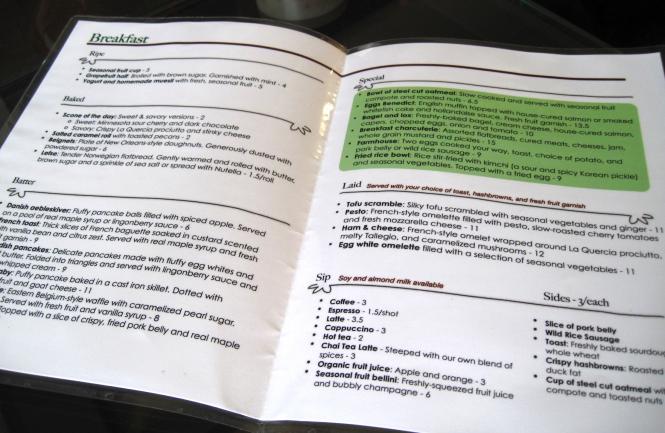 The inside of my breakfast menu.Truth telling in menu
planning also means not taking shortcuts by substituting a lower quality
ingredient for the real deal. How many times have we been served maple-flavored
syrup instead of real maple syrup even though the menu states the latter? Maybe
we’d rather not know. A couple other common examples include using whipped
topping instead of real whipped cream, offering a Roquefort salad dressing that’s
made with a different variety of blue cheese, or substituting a less expensive
fish for another. If a restaurant changes out a stated product, the menu needs
to reflect this change.
The inside of my breakfast menu.Truth telling in menu
planning also means not taking shortcuts by substituting a lower quality
ingredient for the real deal. How many times have we been served maple-flavored
syrup instead of real maple syrup even though the menu states the latter? Maybe
we’d rather not know. A couple other common examples include using whipped
topping instead of real whipped cream, offering a Roquefort salad dressing that’s
made with a different variety of blue cheese, or substituting a less expensive
fish for another. If a restaurant changes out a stated product, the menu needs
to reflect this change.
Food Allergies and Nutritional Claims
Being knowledgeable about food allergies and nutrition also relates to writing accurate and truthful menus. It’s especially important to understand common food allergies and deliver a truly allergen-free item if stated or guaranteed. The same applies to nutritional claims describing dishes as low-fat or “healthy.” For the purposes of our menu class, our teacher assigned us to include two healthy entrees in our lunch menu, defined as having 400 calories or less. We had to use calorie-counting tools and create two meals that weren’t only healthy for healthiness’ sake, but also appealing. Finding starches that didn’t push the calorie limit over 400 was the most difficult part of this assignment. I learned that grains such as quinoa and brown rice weren’t significantly lower in calories than starches like bread or pasta, and that sweet potatoes were surprisingly low. Hungry Girl’s Lisa Lillian would have found this exercise thrilling, as she seems to define health by counting calories. I even used one of her swaps by including tofu shirataki noodles which only amount to about 20 calories per serving.
Pricing
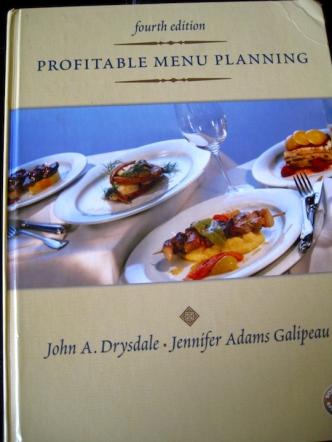 Our menu planning textbook, Profitable Menu Planning.Next fall, when we’re second
year students, we will spend our semester focusing on pricing techniques in
more depth. Keeping this in mind, our teacher debriefed us on the concept of “psychological
pricing,” which refers to understanding how the customer perceives prices. Our
textbook states this technique was used in retail long before it was used in
the restaurant industry; Wal-Mart comes to mind as a prime example of a
retailer using psychological pricing.
Our menu planning textbook, Profitable Menu Planning.Next fall, when we’re second
year students, we will spend our semester focusing on pricing techniques in
more depth. Keeping this in mind, our teacher debriefed us on the concept of “psychological
pricing,” which refers to understanding how the customer perceives prices. Our
textbook states this technique was used in retail long before it was used in
the restaurant industry; Wal-Mart comes to mind as a prime example of a
retailer using psychological pricing.
Typically, establishments that serve less expensive food utilize psychological pricing because it emphasizes value, while fine dining restaurants might avoid this technique to emphasize quality. “Odd-cents Pricing” states that customers believe prices that end in odd numbers are better values than those that end in even numbers. For example, customers perceive that a $0.99 item is a better value than one that costs $1.00, or that a $1.49 item is a better value than $1.50, even though the difference is merely a penny. Additional psychological pricing research suggests that items that cost between $7-10 dollars should end in fives while prices higher than $10 should end in zeros. Finally, if a restaurant needs to increase its menu prices, psychological pricing recommends keeping the increases below the next dollar whenever possible. For example, customers supposedly perceive a larger difference between $8.99 and $9.30, than $8.25 and $8.56 even though both examples differ by $0.31.
Design
The most challenging part of the menu creation process seemed to be the design. Our teacher provided us with examples of menus from real restaurants and previous classes. He encouraged us to utilize basic design principles such as wisely utilizing white space, choosing fonts that are easy to read, and using no more than three fonts total. We were also encouraged to be mindful about displaying the higher-profiting items like specials and entrees more prominently than items like beverages and desserts. After receiving our basic instructions, we were set loose to our own devices.
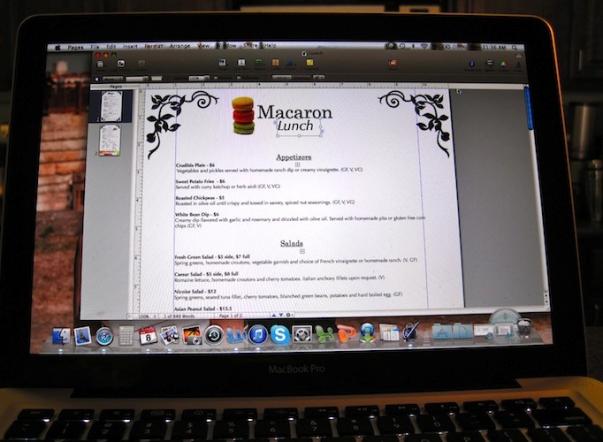 Designing a sample menu.I drew from what I learned
in my undergraduate computer graphic design courses. I was never near the top
of my class in terms of raw talent, but practiced enough to become competent.
Therefore, I found the actual menu design part of my Menu Planning class a
little less stressful than my classmates, most of whom recently graduated from
high school and have had no experience with design software. Many utilized
Microsoft Word to design their menus. Although I’ve known of a couple of
whizzes who managed to utilize Microsoft Word to its fullest capacity and
produce professional pieces, I find it extremely unfriendly for design. Basic
print pieces can be created more easily with Microsoft Publisher, or even from
blank slides in Microsoft PowerPoint. I created my menus on a Mac, using Apple
iWork’s Pages and iPhoto. These programs served my basic needs, but are much
more limited than professional design software like Adobe’s InDesign and
Photoshop. Students and teachers who provide proof of their eligibility can
purchase versions of these programs from Apple at a significant discount. Some
restaurants may hire professional designers to produce their menus, but with
some basic design knowledge and practice, a restaurateur could design their own
menus and save some money.
Designing a sample menu.I drew from what I learned
in my undergraduate computer graphic design courses. I was never near the top
of my class in terms of raw talent, but practiced enough to become competent.
Therefore, I found the actual menu design part of my Menu Planning class a
little less stressful than my classmates, most of whom recently graduated from
high school and have had no experience with design software. Many utilized
Microsoft Word to design their menus. Although I’ve known of a couple of
whizzes who managed to utilize Microsoft Word to its fullest capacity and
produce professional pieces, I find it extremely unfriendly for design. Basic
print pieces can be created more easily with Microsoft Publisher, or even from
blank slides in Microsoft PowerPoint. I created my menus on a Mac, using Apple
iWork’s Pages and iPhoto. These programs served my basic needs, but are much
more limited than professional design software like Adobe’s InDesign and
Photoshop. Students and teachers who provide proof of their eligibility can
purchase versions of these programs from Apple at a significant discount. Some
restaurants may hire professional designers to produce their menus, but with
some basic design knowledge and practice, a restaurateur could design their own
menus and save some money.
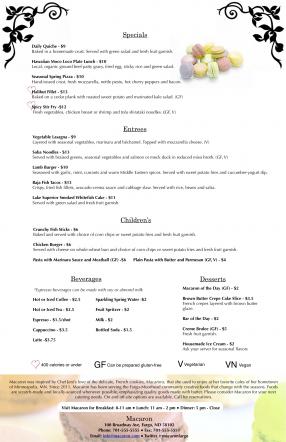 The second page of my final menu planning project (first page at top)This class provided me with
an opportunity to translate my daydreams of restaurant ideas and wish lists of
my favorite foods into breakfast and lunch menus. The items in my menus
borrowed flavors from places from where I have traveled and worked, and
reflected both my biological and adopted Korean and Scandinavian heritages. I
chose to stick with an overall theme of local and organic cafe foods, a type of
restaurant I wish was more prevalent in Fargo, and enjoyed the diversity of
themes my classmates brought to the table. Many integrated their own family
heritages into their restaurant concepts and menus such as one student who
created her restaurant around the real location of her ancestors’ farmstead
along the main street of its small town. Another student themed her restaurant
around different types of dumplings and a few others created sports bars. Some
pushed the creative envelope even further by designing a strip club breakfast
menu and a Macaulay Culkin-themed restaurant.
The second page of my final menu planning project (first page at top)This class provided me with
an opportunity to translate my daydreams of restaurant ideas and wish lists of
my favorite foods into breakfast and lunch menus. The items in my menus
borrowed flavors from places from where I have traveled and worked, and
reflected both my biological and adopted Korean and Scandinavian heritages. I
chose to stick with an overall theme of local and organic cafe foods, a type of
restaurant I wish was more prevalent in Fargo, and enjoyed the diversity of
themes my classmates brought to the table. Many integrated their own family
heritages into their restaurant concepts and menus such as one student who
created her restaurant around the real location of her ancestors’ farmstead
along the main street of its small town. Another student themed her restaurant
around different types of dumplings and a few others created sports bars. Some
pushed the creative envelope even further by designing a strip club breakfast
menu and a Macaulay Culkin-themed restaurant.
This first half of our Menu Planning course challenged us to plan our own restaurant concepts and write breakfast and lunch menus and the second half will continue to challenge us. In addition to completing the full meal circle by writing a dinner menu, we will create buffet and sit-down catering menus and close the semester by designing coupons and radio advertisements. Obviously, this single course will not make us experts at menu creation or prevent us from becoming the next generation of restaurant failures, but it will guide us down the right path as we look toward opening real restaurants of our own.

Jeni Hill grew up in the Twin Cities and recently moved to Fargo. Her two sustaining passions are food and writing and she combines the two whenever she gets the chance. Jeni believes food is never just about the food and considers it the finest medium to connect with others. When she is not crafting contributions to Simple Good & Tasty, she may be posting to her blog An Herbalist Eats, 20food, or Fargo's High Plains Reader. Her last series for SGT was Farm to Fork, a CSA Series.

